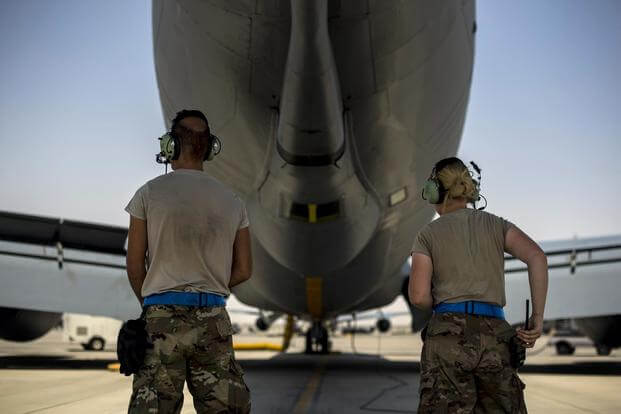The U.S. Air Force is holding steady in its refueling mission over the Horn of Africa, including refueling Saudi coalition aircraft striking Houthi targets in Yemen, as lawmakers once again prepare to debate a resolution to halt U.S. aerial assistance for those strikes.
As of Aug. 31, Air Force tankers had conducted 2,919 sorties and offloaded 92.3 million pounds of fuel to coalition fighters in the area of operations since the onset of the Yemen crisis in 2015, according to recent statistics provided to Military.com.
KC-135 Stratotankers and KC-10 Extenders have participated in 12,102 refueling operations, or what officials describe as "refueling events," since April 2015, U.S. Central Command officials said.
According to the previous update provided by Air Forces Central Command spokeswoman Capt. AnnMarie Annicelli in March, the service had conducted more than 2,800 refueling operations over the Horn of Africa as of Jan. 1, 2018, offloading "88 million pounds of fuel in support of U.S. missions and Saudi and Emirate operations against threats throughout the Horn of Africa, to include Yemen."
Refueling events were not provided to Military.com at the time.
From the start of the conflict in April 2015 until October 2017, Air Force tankers participated in 2,363 sorties in the Horn of Africa region, with more than 10,400 refueling events, offloading nearly 80 million pounds of fuel.
The latest data "provided does not break down the origin of the individual receivers," Army Maj. Josh Jacques, a CENTCOM spokesman, said in a statement earlier this month.
Related content:
- US Will Keep Refueling Saudi Coalition Warplanes -- for Now
- General Argues to Continue Refueling Saudi Planes in Yemen Fight
- Lawmakers Want to Force US Military Out of Yemen War
Prior to last year, AFCENT, the subordinate, major command to CENTCOM that for years provided statistics to this Military.com, routinely produced the refueling statistics and said the data were specific to jets refueling for operations in Yemen. But last fall, officials said they had erred in the way they previously provided statistics because they had no way of tracking refueling missions specific to Yemen or to individual jets and aircraft receiving fuel.
Refueling numbers are tracked by the command but, unlike statistics on strikes and sorties against the Islamic State and the Taliban, aren't publicly released via the command's airpower summary factsheets.
However, the liaison program between the U.S. and Saudi Arabia that keeps U.S. intelligence personnel embedded with the Royal Saudi Air Force is ongoing, Jacques said.
"We deployed liaisons to Saudi Arabia in part to share best practices with the Royal Saudi Air Force [RSAF] and advise them on how to avoid civilian casualties," he said. "Consistent with U.S. law, existing agreements and regulations, the liaisons also can respond to RSAF requests for information about threats to Saudi border security and associated threat networks."
Jacques stressed, "Liaisons advise on best practices for aerial targeting processes. But liaisons are not involved in the specific selection of targets or prioritizing and matching responses for combat missions."
Whether the U.S. should be so intimately involved in Yemen has received more attention under the Trump administration, especially in recent weeks following a Saudi-led airstrike that mistakenly hit a bus filled with children.
CNN last month published a report on each of the bomb types used in Yemen strikes, pointing to U.S.-made bombs from defense companies such as Lockheed Martin. It is believed that the strike on the school bus, which killed 40 children Aug. 9, was made using a Lockheed MK 82, the CNN investigation said.
When asked whether Lockheed has seen pushback from lawmakers on Capitol Hill or other leadership over the incident, the company referred Military.com to the Defense Department.
However, Frank St. John, executive vice president of Lockheed Martin Missiles and Fire Control, said in an interview at the annual Air Force Association Air, Space and Cyber conference last week, "Our focus is always on supporting our DoD customers. We just support them, and that hasn't changed."
Then-President Barack Obama halted precision-strike weapons sales to Saudi Arabia in the aftermath of a 2016 airstrike that killed more than 150 civilians attending a funeral in Sana'a. The Trump administration lifted the sales ban in 2017.
Lawmakers recently announced another attempt to invoke the War Powers Resolution of 1973, which would force the U.S. to end its involvement in the Saudi-led conflict within 30 days of passage, unless voted upon otherwise.
Similar provisions in Congress have not passed.
-- Oriana Pawlyk can be reached at oriana.pawlyk@military.com. Follow her on Twitter at @Oriana0214.










